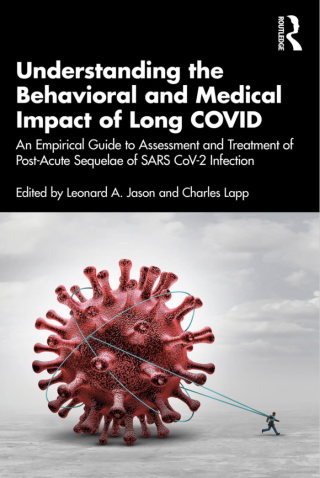Depression
The Pandemic Is Not Over
What have we learned over the past three years.
Posted April 24, 2023 Reviewed by Abigail Fagan
This is not the time to let down our defenses, with over 120,000 new cases and 1,700 deaths caused by COVID each week in the U.S. Regrettably, only 16.7% of Americans have updated booster doses. SARS-CoV-2 not only induces respiratory symptoms but can affect multiple organ systems, including the kidneys, gastrointestinal tract, heart, and brain. SARS-CoV-2 is known to cause strokes, venous sinus thrombosis, encephalitis, and acute sensorimotor neuropathies. There have been over 760 million confirmed cases of COVID-19 as of April (World Health Organization, 2023). Most persons infected with SARS-CoV-2 remain asymptomatic, but many experience mild (40%) or moderate (40%) disease. Approximately 15% develop severe COVID-19 that requires oxygen support. An 18-month follow-up of those with symptomatic infections found that 6% had not recovered and 42% had recovered only partially.
Clues are beginning to emerge as to why some have persisting symptoms following COVID-19. There is a higher risk of Long COVID in those with a more severe initial infection, but Long COVID can occur even after a mild infection. Risk factors for developing Long COVID include the presence of Epstein Barr virus, SARS-CoV-2 virus, certain auto-antibodies, diabetes type II, obesity, high blood pressure, chronic lung disease, and depression.
For example, the lingering symptoms of difficulty thinking may be caused by ongoing low-grade brain inflammation following the acute viral infection, and even individuals with initial mild COVID symptoms may be vulnerable. While there is no evidence of widespread SARS-CoV-2 infection in the brain, many neurological symptoms of Long COVID-19 are likely a result of a post-inflammatory response including the presence of antibodies that react with the nervous system. The inflammatory response occurs particularly around blood vessels, with macrophages producing free radicals and cytokines that persist and cause damage. Finally, COVID-19 infection can also cause some arteries and veins in the brain to become thin; breaks in small blood vessels can cause bleeding in the brain. COVID-19 can also cause blood cells to form clots in arteries and veins which reduce or block the flow of blood, oxygen, and nutrients that cells need to function and can lead to a stroke. In sum, the inflammatory immune system response to the virus, injury to blood vessels, and lack of oxygen in the brain may account for diagnostic images that show changes in the brain’s white matter that contains the long nerve fibers, which transfer information from one brain region to another. This “diffuse white matter disease” might contribute to cognitive difficulties.
The neurocognitive problems that intensify over time in some patients with Long COVID are similar to those in patients with myalgic encephalomyelitis/chronic fatigue syndrome (ME/CFS) Several studies have indicated that about 40% of patients with Long COVID fulfilled ME/CFS criteria. The clinical similarities between ME/CFS and ME/CFS-Long COVID allow us to suggest common pathobiology. With Long COVID, there is evidence that the initial SARS-CoV-2 infection reactivates latent viruses such as Epstein Barr virus, which has been linked to many other illnesses including multiple sclerosis. By studying those who test negative for SARS-CoV-2, but have ME/CFS, we could learn more about the relationship between Epstein Barr Virus and both Long COVID and ME/CFS.

A recent book by international scholars around the world, edited in part by one of us, Leonard Jason, Understanding the Behavioral and Medical Impact of Long COVID, describes what is known in different areas of functioning affected by Long COVID and how this knowledge can facilitate the application of appropriate assessment and treatment. There are clear benefits that can occur when multidisciplinary approaches can help better understand the complicated behavioral and medical systems of those affected by Long COVID. We all remain at risk for this deadly virus, and we need to continue to exercise caution and engage in safe behaviors to protect ourselves and our loved ones.
References
Coronavirus and the Nervous System (2023). National Institute of Neurological Disorders and Stroke, Washington, D.C. Available at: https://www.ninds.nih.gov/current-research/coronavirus-and-ninds/coronavirus-and-nervous-system
Hastie CE, Lowe DJ, McAuley A, Winter AJ, Mills NL, Black C, et al. Outcomes among confirmed cases and a matched comparison group in the Long-COVID in Scotland study. Nat Commun. 2022 Oct 12;13(1):5663
Jason, L.A., Islam, M., Conroy, K., Cotler, J., Torres, C., Johnson, M., & Mabie, B. (2021). COVID-19 symptoms over time: Comparing Long-Haulers to ME/CFS. Fatigue: Biomedicine, Health & Behavior, 9(2), 59-68. http://dx.doi.org/10.1080/21641846.2021.1922140
Jason, L.A., & Lapp, C. (Eds.)(2023). Understanding the Behavioral and Medical Impact of Long COVID: An Empirical Guide to Assessment and Treatment of Post-Acute Sequelae of SARS CoV-2 Infection. New York, NY: Routledge.
Komaroff, A. (2023). Does COVID-19 damage the brain? Harvard Health Letter, Available at: https://www.health.harvard.edu/mind-and-mood/does-covid-19-damage-the-brain.
Lee M-H, et al. Neurovascular injury with complement activation and inflammation in COVID-19. Brain. 2022.
World Health Organization. (2023, March). WHO coronavirus (COVID-19) dashboard. Available at: https://covid19.who.int (accessed 6 April 2023).


